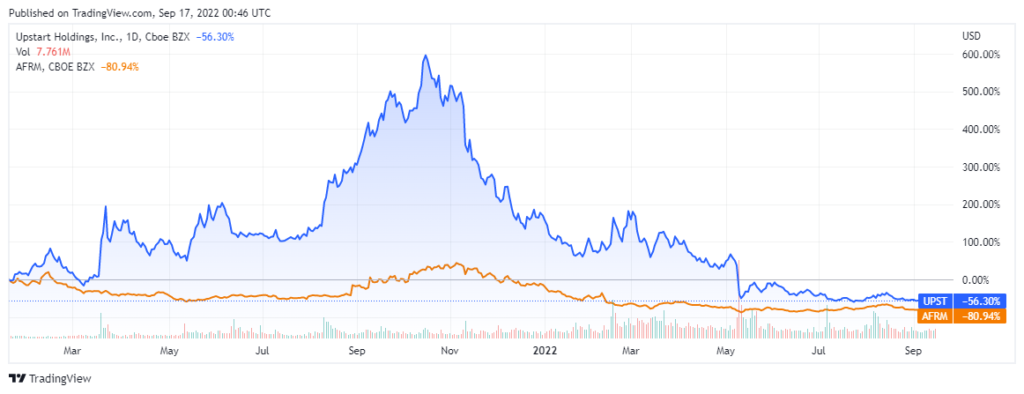Upstart (NASDAQ: UPST) and Affirm (NASDAQ: AFRM) were two of the most sought-after IPOs in late 2020 and early 2021. The two companies saw their shares surge during the first few months of trading in the public markets. Yet, Upstart & Affirm are currently trading around 94% and 87% off their all-time highs – quite a staggering development.
Invest with Confidence:
- Follow TipRanks' Top Wall Street Analysts to uncover their success rate and average return.
- Join thousands of data-driven investors – Build your Smart Portfolio for personalized insights.

In this article, I am going to provide some context on what caused such massive declines following the IPO euphoria of 2020 and 2021 and then speculate which one of the two names has the higher chance of making investors’ money back.
What Caused Upstart & Affirm to Surge Only to Violently Decline After?
The IPO market went nuts last year, and for a good reason. With investors riding the euphoria formed by the post-COVID-19 recovery, trillions of dollars flooding the market following government assistance to businesses and individuals, and monetary easing encouraging cheap borrowing, inflated valuations persisted strongly. Thus, it was probably the best time in history to take your company public, as investment banks, VC funds, and angel investors could exit their holdings at fantastic multiples.
To add some color to the picture, in 2019 and 2020, 232 and 480 IPOs were completed. In fact, 480 was a new record at the time. In 2021, this number skyrocketed to an unprecedented 1,035, more than two times higher than the previous year’s record. Then, reality knocked on investors’ doors.
Who would have thought that printing over $5 trillion dollars would cause inflation levels to surge? Some did, and inflation certainly did surge. In fact, it remains at sky-high levels. Then, things took a contrasting turn. With the FED eager to control inflation via rising interest rates, the economy has been set to slow down.
Add growing costs amid supply-chain constraints and a tight labor market, and the previously sky-high valuation multiples were no longer justifiable by any means possible. It’s no wonder that during the first nine months of 2022, only 153 IPOs have taken place – a fraction compared to last year.
The majority of the companies that went public amid last year’s euphoria would never make enough money any time soon to justify their stock prices, hence why many of these stocks declined by 80% to 90% from their all-time highs in the span of a few months. Upstart and Affirm were met with the same fate. In fact, these companies were affected massively due to their business model requiring a thriving economy to produce growing results.
Which Stock Has the Chance to Make Your Money Back?
As just mentioned, Upstart and Affirm, in particular, require blossoming economic conditions to grow since the former’s business model is focused on lending and the latter’s on buy-now-pay-later (BNPL). As you can easily imagine, nobody is going to borrow money or buy products that they may not be able to repay later. Thus, the two businesses have a hard time in a rising-rate environment loaded with uncertainty.
However, if I had to bet which stock has the higher chance of coming back from the dead, it would definitely be Upstart. This is due to its lean, margin-rich business model, which should start building equity value on the balance sheet quite rapidly. For context, Upstart’s gross and EBITDA margins over the past four quarters amount to 83.7% and 9.7%, respectively. In the case of Affirm, these figures stand at 49% and -53%.

Clearly, Upstart’s current and future profitability prospects are levels ahead of Affirm’s. Most certainly, investors are unlikely to prefer a money-losing business in the current environment. This is because raising additional funds these days would be disastrous. Investors would be massively diluted for the extra cash at the stock’s current price levels.
Upstart’s business model has the upper hand here, as even though lending volumes may decline, the company continues to license its AI platform to banks, which results in high-margin, recurring cash flows. In fact, while lending activities may shrink, banks actually need Upstart’s AI more than ever to filter between creditworthy and uncreditworthy borrowers in the current environment.
Affirm loses here, as merchants aren’t encouraged to use its platform if they think the current economic conditions will prevent customers from paying back their commitments.
From a margin of safety point of view, Upstart stock also has the upper hand. The company is currently trading at around 19.6x Fiscal 2023’s expected earnings, which is quite an attractive valuation multiple considering that it could grow notably from there if economic conditions improve. Again, making money these days is truly important.
Further, due to Upstart management recognizing the fact that shares are cheap against the company’s future profit prospects, earlier this year, they announced a $400 million repurchase program. No repurchases have taken place yet, though the program makes for a good reminder that the company is profitable and will be returning capital to shareholders.
In contrast, Affirm is not expected to make any money, at least all the way through Fiscal 2025, if not for longer. Thus, investors have little to no margin of safety in comparison, with the company’s equity value likely to go down the drain during this time.
Conclusion: Upstart Looks Like the Better Choice
Between Upstart’s AI-lending and Affirm’s BNPL business models, the former has a clear advantage during the ongoing macroeconomic landscape. Additionally, Upstart profitability prospects are much more attractive, providing investors with a much wider margin of safety against Affirm’s money-losing operations. This, combined with the fact that Upstart is trading at a relatively cheap valuation, leads me to the conclusion that Upstart has a significantly higher chance of repairing investors’ recent losses.









